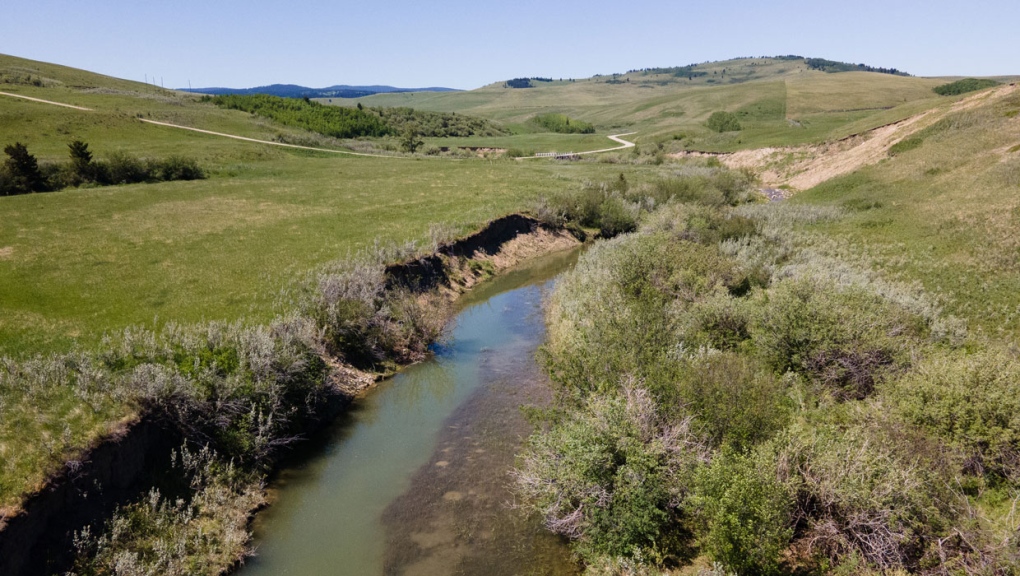Parcel of land near Claresholm, Alta. set aside to protect at-risk species
 Almost 650 hectares of land have been added to an existing region of protected grassland west of Claresholm, Alta. (Supplied/NCC/Brent Calver)
Almost 650 hectares of land have been added to an existing region of protected grassland west of Claresholm, Alta. (Supplied/NCC/Brent Calver)
A section of land has been added to a protected area along southern Alberta's Porcupine Hills, a region filled with grasslands and forests that are home to at-risk birds and trees.
Nature Conservancy of Canada (NCC) says the 643-hectare property located west of Claresholm in the M.D. of Willow Creek will create a single protected block of approximately 1,900 hectares. It will also add to the almost 7,700 hectares of protected land along the eastern edge of the Porcupine Hills.
The land itself is very important to many species, NCC says, because grasslands "are one of the most at-risk ecosystems on the planet."
"Over 80 per cent of this project's area features high-quality fescue grasslands," NCC said in a release.
"Protecting this ecosystem will maintain habitat for grassland wildlife, including Sprague's pipit, a songbird listed as 'threatened' under the federal Species at Risk Act, and nutritious winter forage for deer, elk and cattle."
NCC says the site also includes 96 hectares of riverbank habitat as well as forests at its highest elevations, which is home to limber pine, an endangered species of tree.
"This area contains such a rich array of habitats," said Lee Moltzahn, NCC's natural area manager, in a release. "From Trout Creek, which supports several fish species and shorebirds, to its fescue grasslands, which are important for grazing elk and nesting songbirds, and to the ridgetop forests with imperiled limber pine, this place is home to some of Alberta's most important and iconic species."
Other species observed on or near the property include the golden eagle (sensitive in Alberta), the ferruginous hawk (threatened federally, at-risk in Alberta), the great blue heron (sensitive), eastern kingbird (sensitive) and sharp-tailed grouse (sensitive).
NCC says the region will also serve as core habitat for grizzly bears.
 (Supplied/NCC/Brent Calver)
(Supplied/NCC/Brent Calver)
The project, made possible through the assistance of the Government of Canada, illustrates how the NCC "is accelerating the pace of conservation in Canada."
"A conservation agreement between NCC and the property's landowner voluntarily restricts development and conversion rights on the land. This legal agreement will ensure that the property continues operating as a working cattle ranch, while maintaining the landscape in a natural, healthy, unfragmented state."
In the past two years, NCC has aided in the protection of more than 1 million hectares of land in Canada.
CTVNews.ca Top Stories

'Still working full time on it:' One year later police continue to search for gunman in Caledon double murder linked to ex-Olympian
One year after a couple was shot and killed in their Caledon home in what investigators have described as a case of mistaken identity, Ontario Provincial Police say they are still trying to figure out who pulled the trigger.
A man called 911 for help during a home invasion. Las Vegas police fatally shot him
A Las Vegas man called for police help during a home invasion before an officer fatally shot him, according to authorities and 911 calls.
Scurvy resurgence highlights issues of food insecurity in Canada's rural and remote areas
A disease often thought to only affect 18th century sailors is reemerging in Canada.
These royal residences are opening their doors this Christmas
Not so long ago, if you wanted to spend Christmas with the royal family, the only way to get close was to press your nose up to the TV screen during the monarch’s Christmas speech.
Cat caught in hunting snare rescued by BC SPCA
Donations are ramping up for a BC SPCA cat with a mangled paw after being caught in a hunting snare, one of a rising number of pets to fall prey to the hunting device.
Jannik Sinner leads Italy past the Netherlands for its second consecutive Davis Cup title
Jannik Sinner clinched Italy’s second consecutive Davis Cup title and capped his breakthrough season by beating Netherlands' Tallon Griekspoor.
Lotto Max jackpot hits $80M for second time ever
The Lotto Max jackpot has climbed to $80 million for just the second time in Canadian lottery history.
Montreal police chief expects additional arrests following anti-NATO protest
Montreal's police chief says he expects more arrests stemming from a Friday anti-NATO protest that turned violent, with smashed windows and burned cars in downtown Montreal.
After Trump's Project 2025 denials, he is tapping its authors and influencers for key roles
After being elected the 47th president on Nov. 5, Donald Trump is stocking his second administration with key players in the Project 2025 movement he temporarily shunned.
































